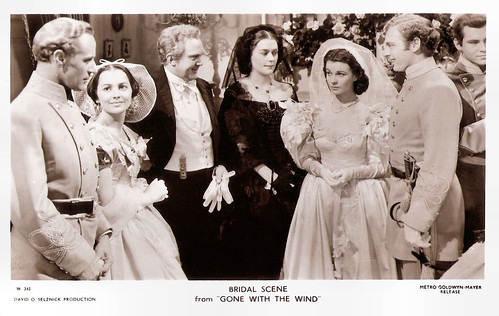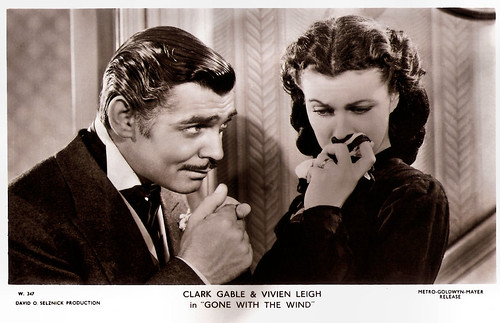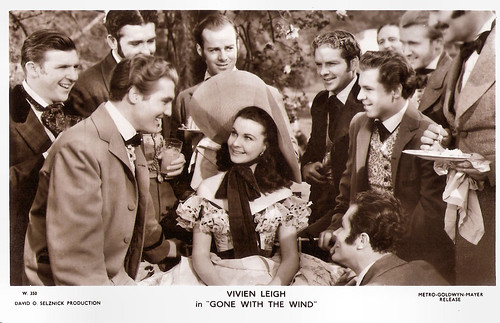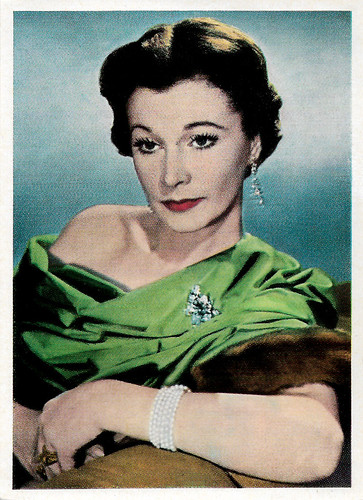Extraordinarily beautiful British actress Vivien Leigh (1913-1967) won two Academy Awards for playing Southern belles: Scarlett O'Hara in Gone with the Wind (1939) and Blanche DuBois in A Streetcar Named Desire (1951). On stage, she starred – often with her husband, Laurence Olivier - in parts that ranged from the heroines of Noel Coward and George Bernard Shaw comedies to Shakespearean characters like Ophelia, Juliet and Lady Macbeth.


Italian postcard by Zincografica, Firenze. Photo: Vivien Leigh and Clark Gable in Gone with the Wind (Victor Fleming, 1939).

French postcard by Éditions P.I., Paris, no. 321 Photo: Metro Goldwyn Mayer.

British postcard by Art Photo, no. 104. Photo: London Film / Erich Pommer Production. Vivien Leigh and Laurence Olivier in Fire Over England (William K. Howard, 1937).

British Art Photo postcard, no. 123. Photo: Victor Saville / London Films. Vivien Leigh and Rex Harrison in Storm in a Teacup (Ian Dalrymple, Victor Saville, 1937).

Spanish postcard by C y A, no. 89. Photo: Mundial Films / Warner Bros. Vivien Leigh and Warren Beatty in The Roman Spring of Mrs. Stone (José Quintero, 1961).

Dutch postcard by Filmfreak Productions / Painted Movies, no. FA 386. Illustration by Renato Casaro for Gone with the Wind (Victor Fleming, 1939).
Fire over England
Vivien Leigh was born Vivian Mary Hartley in Darjeeling, India, to Ernest Hartley, a British Officer in the Indian Cavalry, and Gertrude Robinson Yackje. In 1917, her father was relocated to Bangalore, while Vivian and her mother stayed in Ootacamund.
At age six, Vivian was sent to a convent school in England. In addition to taking the usual classes, Vivian studied violin, piano, cello, and ballet, and participated in school plays. A friend there was the future actress Maureen O'Sullivan, to whom she expressed her desire to become 'a great actress'.
In 1931 her father helped her enrol at the Royal Academy of Dramatic Art (RADA) in London. She met Herbert Leigh Holman, known as Leigh, a barrister thirteen years her senior. Despite his disapproval of ‘theatrical people’, they were married in 1932, and upon their marriage, she terminated her studies at RADA. In 1933, she gave birth to a daughter, Suzanne, but felt stifled by her domestic life. Her friends suggested her for a small part in Things Are Looking Up (Albert de Courville, 1935), which marked her film debut.
She engaged an agent, John Gliddon, who recommended her to film director and producer Alexander Korda, but he rejected her as lacking potential. Cast in the play 'The Mask of Virtue' in 1935, Vivien Leigh received excellent reviews followed by interviews and newspaper articles. Korda, who attended her opening-night performance, admitted his error and signed her to a film contract.
Laurence Olivier saw Leigh in 'The Mask of Virtue', and a friendship developed after he congratulated her on her performance. While playing lovers in the film Fire Over England (William K. Howard, 1937), Olivier and Leigh developed a strong attraction, and after filming was completed, they began an affair. Olivier was at that time married to the actress Jill Esmond.

British postcard in the Picturegoer Series, London, no. 1224. Photo: Cannons.

British postcard in the Picturegoer series, London, no. 1124b. Photo: Paramount.

British postcard in the Picturegoer Series, London, no. D 133. Photo: Warner Bros.

British postcard in the Picturegoer Series, London, no. W 422. Photo: London Film Productions.

British postcard by Theatre Museum, no TNM 46. Photo: J.W. Debenham. Vivien Leigh as Titania in 'A Midsummer Night's Dream' by William Shakespeare, Old Vic Theatre, 1937.

British Real Photograph postcard, no. F.S. 71. Photo: Antony Beachamp. Caption: Vivien Leigh, screen heroine of Gone With The Wind is not only one of the most beautiful women in the world, she is also a superb stage and screen actress. Her husband is Sir Laurence Olivier.

British postcard in the Picturegoer Series, London, no. W. 345. Photo: David O'Selznick Production / Metro-Goldwyn-Mayer. Leslie Howard, Olivia De Havilland and Vivien Leigh in Gone with the Wind (Victor Fleming, 1939). Caption: Bridal scene from Gone with the Wind.
Fire over Atlanta
Vivien Leigh played Ophelia in Olivier's 'Hamlet' in an Old Vic Theatre production. They began living together, as their respective spouses had each refused to divorce. Leigh appeared with Conrad Veidt in the spy thriller Dark Journey (Victor Saville, 1937), and with Robert Taylor and Maureen O'Sullivan in A Yank at Oxford (Jack Conway, 1938). During the production of the latter, she developed a reputation for being difficult and unreasonable, and Korda instructed her agent to warn her.
Her next role was in St. Martin's Lane/Sidewalks of London (Tim Whelan, 1938) with Charles Laughton and Rex Harrison. Laurence Olivier travelled to Hollywood to play Heathcliff in Samuel Goldwyn's production of Wuthering Heights (William Wyler, 1939), leaving Vivien Leigh in London. She was offered the secondary role of Isabella, but she refused it, saying she would only play Cathy, a role already assigned to Merle Oberon.
Leigh's American agent was the London representative of the Myron Selznick Agency, and in 1938, she asked that her name be placed in consideration for the role of Scarlett O'Hara in David O. Selznick's (Myron’s brother) production of Gone with the Wind (Victor Fleming, 1939 an epic adaptation of the bestseller by Margaret Mitchell. David O. Selznick watched her films, and from that time she became a serious contender for the part. Leigh travelled to Los Angeles, ostensibly to be with Olivier.
When Myron Selznick, who also represented Olivier, met Leigh, he felt that she possessed the qualities his brother was searching for. Myron took Leigh and Olivier to the set where the burning of the Atlanta Depot scene was being filmed and introduced Leigh. The following day, Leigh read a scene for Selznick, who organised a screen test and wrote to his wife, "She's the Scarlett dark horse and looks damn good. Not for anyone's ear but your own: it's narrowed down to Paulette Goddard, Jean Arthur, Joan Bennett and Vivien Leigh".
Filming proved difficult for Leigh; director George Cukor was dismissed and replaced by Victor Fleming, with whom Leigh frequently quarrelled. Her role opposite Clark Gable brought Leigh immediate attention and fame. Among the ten Academy Awards won by Gone with the Wind was the Best Actress award for Leigh, who also won a New York Film Critics Circle Award for Best Actress.

British postcard in the Picturegoer Series, London, no. W. 346. Photo: David O'Selznick Production / Metro-Goldwyn-Mayer. Leslie Howard and Vivien Leigh in Gone with the Wind (Victor Fleming, 1939).

British postcard in the Picturegoer Series, London, no. W. 347. Photo: David O'Selznick Production / Metro-Goldwyn-Mayer. Vivien Leigh and Clark Gable in Gone with the Wind (Victor Fleming, 1939).

British postcard in the Picturegoer Series, London, no. W. 349. Photo: David O'Selznick Production / Metro-Goldwyn-Mayer. Vivien Leigh and Hattie McDaniel in Gone with the Wind (Victor Fleming, 1939).

British postcard in the Picturegoer Series, London, no. W. 350. Photo: David O'Selznick Production / Metro-Goldwyn-Mayer. Vivien Leigh in Gone with the Wind (Victor Fleming, 1939).

Belgian postcard by Les Editions d'Art L.A.B., Bruxelles (Brussels), no. 1040. Photo: MGM (Metro-Goldwyn-Mayer). Publicity still for Gone With The Wind (1939). This postcard was given to us by Gill4kleuren.

Belgian postcard by Les Editions d'Art L.A.B., Brussels, no. 2027. Photo: David O'Selznick Production / Metro-Goldwyn-Mayer. Vivien Leigh and Leslie Howard in Gone with the Wind (Victor Fleming, 1939).

Belgian postcard by LAB, no. 2028. Photo: MGM. Photo: Metro Goldwyn Mayer. Clark Gable and Vivien Leigh in Gone with the Wind (Victor Fleming, 1939).
Adulterous Nature
In 1940, Laurence Olivier and Vivien Leigh were married. Leigh hoped to star with her husband and made a screen test for Rebecca (Alfred Hitchcock, 1940). Selznick noted that she didn't seem right as to sincerity or age or innocence, and he subsequently cast Joan Fontaine. He also refused to allow her to join Olivier in Pride and Prejudice (Robert Z. Leonard, 1940), and Greer Garson took the part Leigh had envisioned for herself.
Waterloo Bridge (Mervyn Leroy, 1940) was to have starred Olivier and Leigh; however, Selznick replaced Olivier with Robert Taylor, then at the peak of his success as one of Metro-Goldwyn-Mayer's most popular male stars. Leigh's top billing reflected her status in Hollywood, and the film proved to be popular with audiences and critics.
She and Olivier mounted a stage production of 'Romeo and Juliet' for Broadway. The New York Press publicized the adulterous nature that had marked the beginning of Olivier and Leigh's relationship and questioned their ethics in not returning to England to help with the war effort, and the critics were hostile in their assessment of the production. The couple had invested almost their entire savings into the project, and its failure was a financial disaster for them.
Next, they filmed That Hamilton Woman (Alexander Korda, 1941) with Olivier as Horatio Nelson and Leigh as Emma Hamilton. The film was popular in the United States and an outstanding success in the Soviet Union. The Oliviers returned to England, and Leigh toured through North Africa in 1943, performing for troops before falling ill with a persistent cough and fevers. In 1944 she was diagnosed as having tuberculosis in her left lung. But after spending several weeks in hospital, she appeared to be cured.
When she suffered a miscarriage, she fell into a deep depression. This was the first of many major breakdowns related to bipolar disorder. She was well enough to resume acting in 1946, in a successful London production of Thornton Wilder's 'The Skin of Our Teeth', but her films of this period, Caesar and Cleopatra (Gabriel Pascal, 1945) and Anna Karenina (Julien Duvivier, 1948), were not great successes. In 1947 Olivier was knighted, and Vivien Leigh accompanied him to Buckingham Palace for the investiture. She became Lady Olivier, and after their divorce, per the style granted the divorced wife of a knight, she became, socially, Vivien, Lady Olivier.

Belgian postcard by Les Editions d'Art L.A.B., Bruxelles, no. 2011. Photo: Metro Goldwyn Mayer. Vivien Leigh and Robert Taylor in Waterloo Bridge (Mervyn LeRoy, 1940). The Belgian title was La valse dans l'Ombre.

British postcard in the Picturegoer Series, London, no. 1393. Photo: Metro-Goldwyn-Mayer. Vivien Leigh and Robert Taylor in Waterloo Bridge (Mervyn LeRoy, 1940).

Swiss postcard by News Productions, Baulmes, no. 55833. Photo: W. Eugene Smith. Vivien Leigh and Laurence Olivier in a stage production of 'Romeo and Juliet' in 1940.

Vintage postcard. Photo: Vivien Leigh and Laurence Olivier in That Hamilton Woman / Lady Hamilton (Alexander Korda, 1941).

French postcard by Editions La Malibran, Paris / Saint Dié, no. CA 19. Vivien Leigh in That Hamilton Woman / Lady Hamilton (Alexander Korda, 1941).

Dutch postcard by Hemo. Photo: Eagle Lion. Vivien Leigh in Caesar and Cleopatra (Gabriel Pascal, 1945).

French postcard by Éditions Hazan, Paris, 1995, no. 6479. Vivien Leigh and Marlon Brando in A Streetcar Named Desire (Elia Kazan, 1951).
Romantic, emotionally fragile, and tragic
Vivien Leigh played the role of Blanche DuBois in the West End stage production of Tennessee Williams's 'A Streetcar Named Desire'. Like Blanche, Leigh was romantic, emotionally fragile, and tragic. After a run of 326 performances, she was also engaged for the film version opposite Marlon Brando. The film version, A Streetcar Named Desire (Elia Kazan, 1952) had glowing reviews, and she won a second Academy Award for Best Actress, a BAFTA Award and a New York Film Critics Circle Award for Best Actress.
In 1953, Leigh travelled to Ceylon to film Elephant Walk with Peter Finch. Shortly after filming commenced, she suffered a breakdown, and Paramount Pictures replaced her with Elizabeth Taylor. Olivier returned her to their home in England, where between periods of incoherence, Leigh told him that she had been having an affair with Finch. She gradually recovered over several months.
Noël Coward was enjoying success with the play 'South Sea Bubble', with Leigh in the lead role, but she became pregnant and withdrew from the production. Several weeks later, she miscarried and entered a period of depression that lasted for months.
In 1960, she and Olivier divorced, and Olivier married the actress Joan Plowright. Vivien’s new partner Jack Merivale proved to be a stabilising influence for her. Though she was still beset by bouts of depression, she continued to work in the theatre and in 1963 won a Tony Award for Best Actress in a Musical for her role in 'Tovarich'.
She also appeared in the films The Roman Spring of Mrs. Stone (José Quintero, 1961) opposite Warren Beatty, and in the all-star Ship of Fools (1965, Stanley Kramer). After many long years of battling manic depression and several outbreaks of tuberculosis, Vivien Leigh's body gave out. She died in London in 1967.

Italian postcard by Bromostampa, Milano, no. 105.

Italian postcard by Bromofoto, no. 609. Photo: Warner Bros.

French postcard in the Collection 'Portraits de Cinema' by Editions Admira, Aix-en-Provence & Chapman Collection / SNAP Photos / Cosmos, no. PHN 661. Vivien Leigh and Laurence Olivier in William Shakespeare's 'Antony and Cleopatra' (1951). In 1951 the play ran in repertory with G.B. Shaw's 'Caesar and Cleopatra' at the Ziegfeld Theatre in New York.

Dutch postcard, no. AX 283. (Foto-archief Film en Toneel). Photo: Warner Bros.

British postcard in the Royal Shakespeare Theatre Series, no. 30. Photo: Angus McBean. Vivien Leigh as Viola in 'Twelfth Night', written by William Shakespeare, Stratford-Upon-Avon, 1955.

German collector card in the "Filmstars von Hollywood bis Tokio" series III. Photo: Vivien Leigh in The Deep Blue Sea (Anatole Litvak, 1955).

Romanian postcard by Casa Filmului Acin, no. 475. Vivien Leigh and Lee Marvin in Ship of Fools (Stanley Kramer, 1965).
Vivien Leigh screentests for Gone with the Wind. Source: VivienLeighCom (YouTube).
Vivien Leigh and Robert Taylor dance the farewell waltz in Waterloo Bridge (1940). Source: TheEagle54 (YouTube).
Trailer of A Streetcar Named Desire (1951). Source: British Film Institute (YouTube).
Sources: Brian McFarlane (Encyclopedia of British Film), Leigh Milla (Vivien-Leigh.com - now defunct, Robert Ortiz (Find A Grave), Wikipedia, and IMDb.
hello Bob,
ReplyDeleteShe was a great actress. I'm a fan of old classic movies.
My favourite with Vivien is "A Steetcar named Desire".
Eddy.
I've often wondered if today's medications would have helped her. A great post about a troubled soul.
ReplyDelete